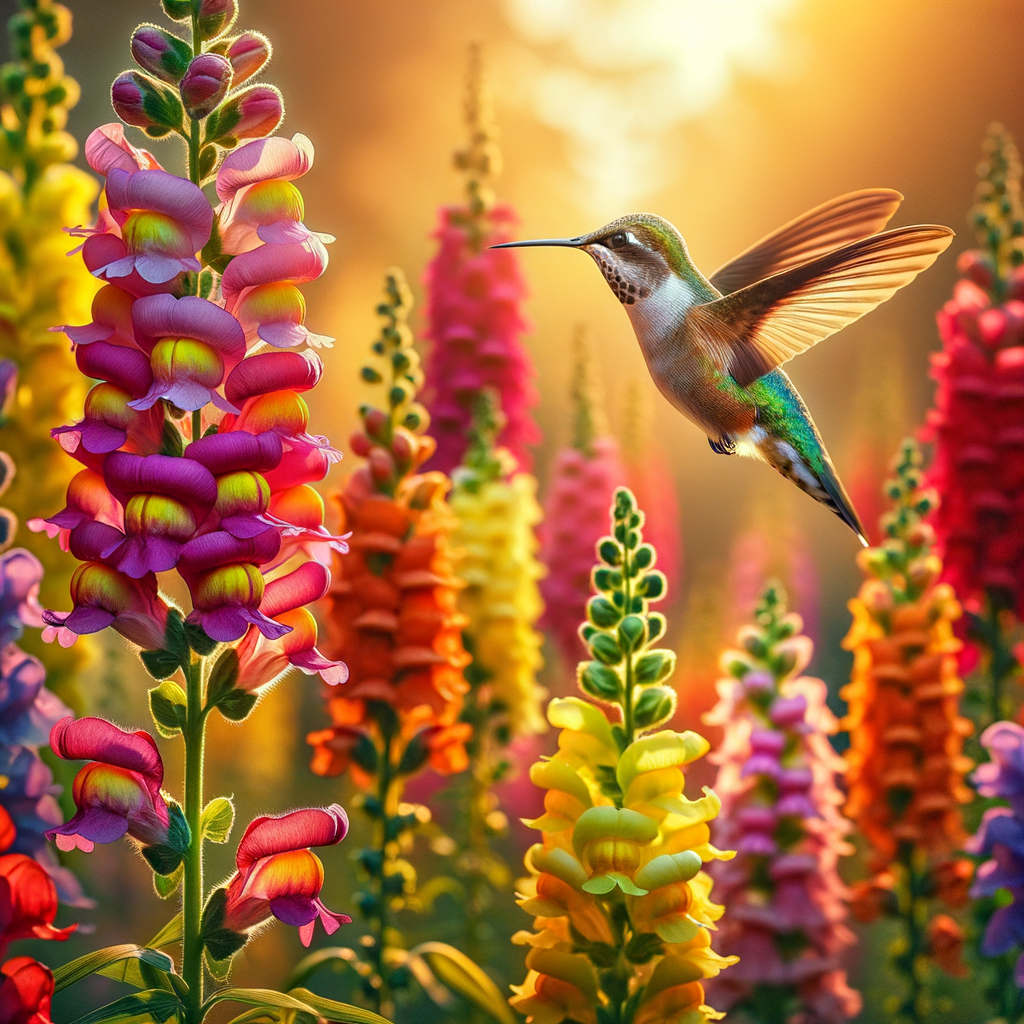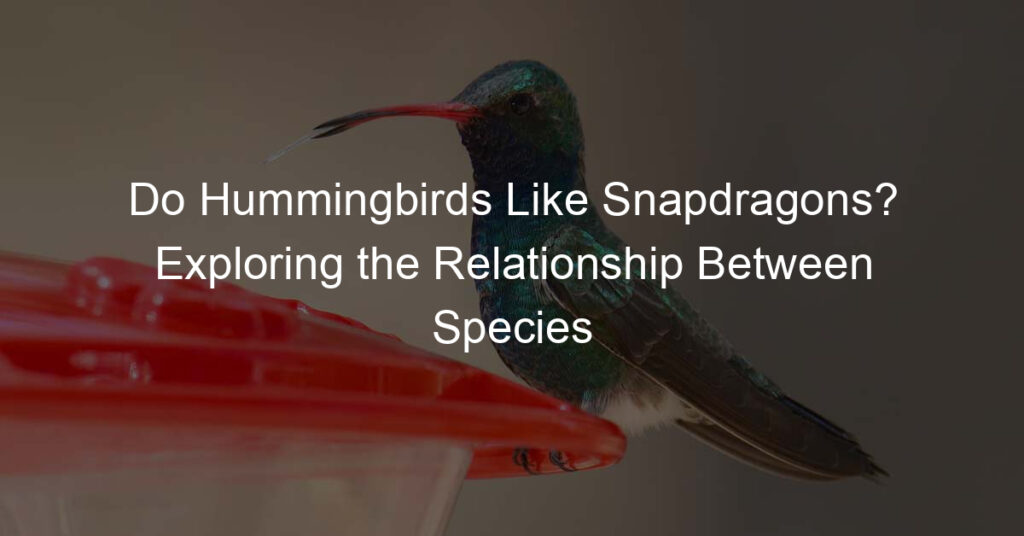Introduction to Hummingbirds and Snapdragons
Welcome to our exploration of the fascinating world of hummingbirds and snapdragons. These two seemingly unrelated species share a unique relationship in nature. Let’s dive in and learn more about these captivating creatures and plants.
Overview of Hummingbirds
Hummingbirds are small, colorful birds with iridescent feathers. Their name comes from the humming noise their wings make as they beat so fast. Hummingbirds are known for their ability to hover in mid-air by rapidly flapping their wings 12–80 times per second. They also have the unique ability to fly in any direction, including backwards. Hummingbirds have a high metabolism to support their speedy lifestyle, requiring them to feed several times per hour.
Overview of Snapdragons
Snapdragons, or Antirrhinum, are a genus of plants that are popular in gardens for their colorful, dragon-shaped flowers. These flowers are unique because they are specially designed to allow pollination by certain types of insects and birds, including hummingbirds. Snapdragons are easy to grow and are often used in gardens to attract a variety of wildlife.
In the following sections, we will delve deeper into the relationship between hummingbirds and snapdragons, how to attract hummingbirds with snapdragons, and other hummingbird-friendly flowers. We will also share a case study of a successful hummingbird garden and conclude with the importance of snapdragons for hummingbirds and beyond.
Attracting Hummingbirds with Snapdragons

Attracting hummingbirds to your garden can be a rewarding experience. One of the most effective ways to do this is by planting snapdragons. But why do hummingbirds love snapdragons so much? Let’s find out.
Why Hummingbirds Love Snapdragons
There are two main reasons why hummingbirds are attracted to snapdragons: color attraction and nectar availability.
Color Attraction
Hummingbirds are attracted to bright colors, especially red. Snapdragons come in a variety of colors, including vibrant reds and pinks, which can easily catch a hummingbird’s eye. This color attraction helps hummingbirds locate food sources from a distance.
Nectar Availability
Snapdragons are rich in nectar, which is a primary food source for hummingbirds. The unique shape of the snapdragon flower allows hummingbirds to easily access the nectar with their long, slender beaks. This makes snapdragons an excellent choice for attracting these beautiful birds to your garden.
By understanding why hummingbirds are attracted to snapdragons, you can create a garden that is both beautiful to look at and a haven for these delightful creatures. In the next section, we will discuss how to plant snapdragons for hummingbirds.
How to Plant Snapdragons for Hummingbirds
Planting snapdragons to attract hummingbirds is a rewarding task that requires careful planning and execution. Here are some key steps to follow:
Choosing the Right Location
Snapdragons thrive in full sun to partial shade. They prefer well-drained soil and a location that receives at least six hours of sunlight each day. A south or east-facing garden is ideal. This is because hummingbirds are attracted to bright, sunny areas where they can easily spot the vibrant colors of the snapdragons. Snapdragons also need some protection from strong winds, so consider planting them near a wall or fence.
Planting Techniques
Start by preparing the soil. It should be rich in organic matter and well-drained. Dig a hole that is twice as wide and the same depth as the root ball of the snapdragon plant. Place the plant in the hole and backfill with soil, pressing down firmly. Water the plant thoroughly after planting. Snapdragons should be spaced about 12 inches apart to allow for growth and air circulation. Regular watering and feeding with a balanced fertilizer will ensure healthy, vibrant flowers that are sure to attract hummingbirds.
By choosing the right location and using proper planting techniques, you can create a beautiful garden filled with snapdragons that will attract hummingbirds. Remember, the key is to provide a habitat that meets the needs of these fascinating creatures. Happy gardening!
Hummingbird-friendly Flowers: Beyond Snapdragons
While snapdragons are a favorite of hummingbirds, there are many other flowers that these tiny birds love. Let’s explore some of them.
Other Flowers Hummingbirds Love
Hummingbirds are attracted to bright, colorful flowers that produce a lot of nectar. Here are three other flowers that are sure to attract these delightful birds to your garden:
Bee Balm: Also known as Monarda, this flower is a hummingbird favorite. Its bright red, pink, or purple flowers are rich in nectar and its scent attracts hummingbirds from far and wide. Learn more about Bee Balm.
Trumpet Vine: This vigorous climber produces clusters of bright orange-red flowers that are perfect for hummingbirds. The trumpet shape of the flowers provides an ideal landing spot for hummingbirds as they feed. Learn more about Trumpet Vine.
Salvia: Also known as sage, these plants have long, tubular flowers filled with nectar. They come in many colors, but hummingbirds seem to prefer the red and purple varieties. Learn more about Salvia.
By incorporating these flowers into your garden, you can create a hummingbird haven that goes beyond the snapdragons. Remember, the key is to provide a variety of nectar-rich flowers that bloom at different times of the year to ensure a steady food supply for these beautiful birds.
Creating a Diverse Hummingbird Garden
Creating a diverse hummingbird garden is not just about planting flowers. It involves careful planning and providing the right environment for these beautiful creatures. Let’s look at two key aspects: choosing a variety of plants and providing water and shelter.
Choosing a Variety of Plants
Hummingbirds are attracted to a wide range of flowers, not just snapdragons. To create a diverse garden, consider incorporating other hummingbird-friendly flowers such as columbines, bee balms, and salvias. These plants not only add color and variety to your garden but also provide a continuous source of nectar for the hummingbirds.
Providing Water and Shelter
Hummingbirds need more than just nectar to thrive. They also need water for drinking and bathing, and shelter for resting and nesting. You can provide water by setting up a shallow birdbath or a mister. For shelter, consider adding trees and shrubs where hummingbirds can rest and hide from predators.
In conclusion, creating a diverse hummingbird garden involves more than just planting a variety of flowers. It also involves providing the right environment, including water and shelter, for these beautiful creatures to thrive.
Snapdragons in Bird Gardens
When it comes to creating a bird-friendly garden, snapdragons are a fantastic choice. These vibrant flowers not only add a splash of color to your garden, but they also provide numerous benefits for our feathered friends.
Benefits of Snapdragons for Other Birds
Snapdragons are not just for hummingbirds. They offer a host of benefits to other birds as well. Here are a couple of key benefits:
Benefit 1: Food Source
Snapdragons produce nectar, a sweet liquid that many birds find irresistible. Birds like finches and sparrows often feed on snapdragon seeds, providing them with essential nutrients. This makes snapdragons a valuable food source for a variety of bird species.
Benefit 2: Shelter and Nesting
The dense foliage of snapdragons provides excellent cover for birds. They can hide from predators, rest, or even build their nests in the safety of these plants. This makes your garden a welcoming habitat for birds.
By integrating snapdragons into your bird garden, you’re not only enhancing its aesthetic appeal but also contributing to bird conservation. So, why not consider adding some snapdragons to your garden today?
Integrating Snapdragons into a Bird-friendly Garden
Creating a bird-friendly garden with snapdragons is a rewarding endeavor. Not only will you enjoy the vibrant colors and unique shapes of these flowers, but you’ll also attract a variety of birds, including hummingbirds. Here are two simple steps to get you started:
Step 1: Choose the Right Location for Your Snapdragons
Snapdragons prefer full sun to partial shade. They need at least six hours of sunlight each day to thrive. Choose a location in your garden that meets these requirements. If you’re planting snapdragons from seed, prepare the soil by removing weeds and other debris. Add compost or a slow-release fertilizer to provide nutrients for your plants.
Step 2: Plant and Care for Your Snapdragons
Plant your snapdragons in the prepared soil, spacing them about 12 inches apart. Water them thoroughly after planting, and continue to water regularly, especially during dry periods. Snapdragons also benefit from regular deadheading – this is the removal of spent flowers to encourage more blooms.
By following these steps, you can successfully integrate snapdragons into your bird-friendly garden. Not only will these flowers add beauty to your outdoor space, but they’ll also provide a valuable food source for hummingbirds and other birds.
Case Study: A Successful Hummingbird Garden
Let’s delve into a real-life example of a hummingbird garden that has successfully attracted these beautiful creatures with the help of snapdragons and other plants.
Background of the Garden
This garden, located in the heart of California, was initially a barren piece of land. The owner, a passionate bird lover, decided to transform it into a haven for hummingbirds. The goal was to create a sustainable environment for these birds while also providing a visually appealing space for human enjoyment.
Implementation of Snapdragons and Other Plants
The garden owner, after extensive research, chose to plant snapdragons due to their high nectar production and vibrant colors, which are known to attract hummingbirds. Other plants such as bee balm, cardinal flower, and salvia were also added to provide a diverse food source for the birds. The garden was designed in a way that the plants were spaced out, allowing the hummingbirds to fly freely and feed without disturbance.
Results and Key Takeaways
Within a few months, the garden was buzzing with hummingbirds. The snapdragons, in particular, were a big hit. The garden owner noticed that the birds were spending more time in the garden, indicating that they were getting enough nectar from the plants. This case study shows that with the right choice of plants and careful planning, it is possible to create a successful hummingbird garden.
In conclusion, the success of this garden can be attributed to the strategic selection and placement of hummingbird-friendly plants, with snapdragons playing a key role. It serves as an inspiring example for anyone looking to create a similar environment in their own backyard.
Conclusion: Snapdragons for Hummingbirds and Beyond
In this article, we have explored the fascinating relationship between hummingbirds and snapdragons. As we conclude, let’s recap the importance of snapdragons for these tiny birds and share some final thoughts on bird-friendly gardening.
Recap of the Importance of Snapdragons for Hummingbirds
Snapdragons are not just beautiful flowers; they play a crucial role in the survival of hummingbirds. These flowers provide a rich source of nectar, which is the primary food source for hummingbirds. The unique shape of snapdragons also makes them a perfect fit for the long, slender beaks of hummingbirds, allowing these birds to feed efficiently. Moreover, snapdragons bloom for a long period, providing a consistent food source for hummingbirds. Snapdragons are, indeed, an essential part of a hummingbird-friendly garden.
Final Thoughts on Bird-friendly Gardening
Creating a bird-friendly garden goes beyond planting snapdragons. It involves cultivating a diverse range of plants that can provide food, shelter, and nesting sites for different bird species. It also means avoiding the use of harmful pesticides that can harm birds and other wildlife. A bird-friendly garden is not just a haven for birds; it’s a space that supports biodiversity and contributes to the health of our planet. Let’s continue to garden with birds in mind, creating spaces where nature can thrive.
In conclusion, whether you’re a bird lover, a gardening enthusiast, or simply someone who appreciates the beauty of nature, incorporating snapdragons and other bird-friendly plants into your garden can bring immense joy and satisfaction. Not only will you attract hummingbirds and other birds, but you’ll also contribute to the preservation of these wonderful creatures and the ecosystems they inhabit.







